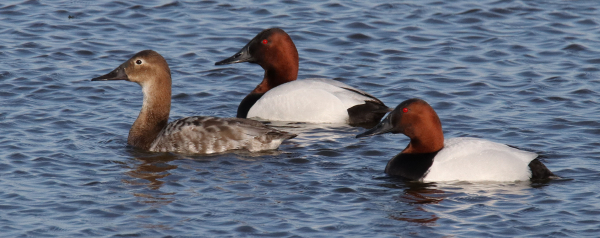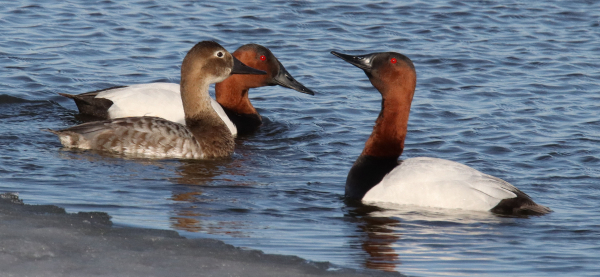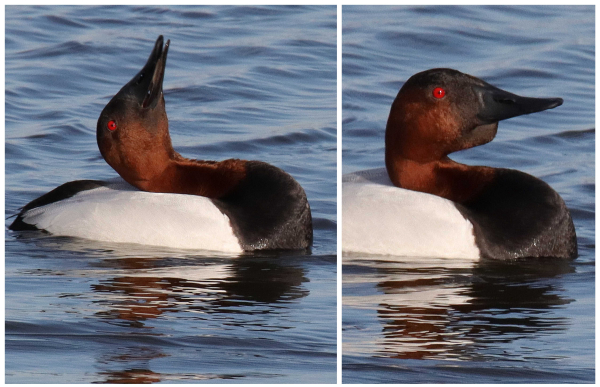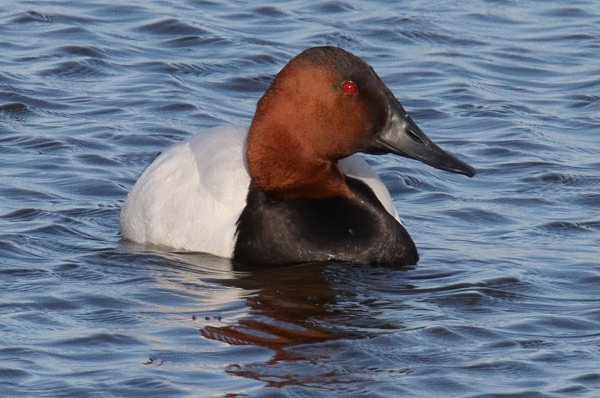These days I live very close to the center of the continent, and within the center of a waterfowl flyway. With 5 species of geese and 15 species of ducks on hand during migration, it’s hard to beat my neighborhood for ducks, geese, and swans during migration. One species in particular always captures my attention, and during the past 10 days Canvasbacks have been very plentiful and very active. Still in migrating flocks, the females are receiving a lot of attention from multiple males at a time, and their mating displays are a vibrant part of the spring action.

Last week I especially enjoyed having a chance to spend time near displaying groups of Canvasbacks at 5 different wetlands. Canvasbacks are a relatively rare sight for most birders, but as I write this Cans are the most abundant ducks in the area, and like Tundra Swans they are favorites that I can’t get enough of, especially if there is a chance of getting a little closer to them with my camera. Leaning toward sunset on Wednesday, there was only a light breeze and the sun was already a bit subdued, but the sunlight created beautiful colors while I slipped into position with the sun at my back and some active Canvasbacks before me, just 4 miles south of my office.

There was still some melting ice along the edges of a bay where a female Can was resting on the ice with an attentive male in the water watching over her and to repel advances from any other drakes. The male provided some nice portrait photographs surrounded by a beautiful shade of blue water reflected from the cloudless sky overhead. A couple male Canvasbacks approached as I waited and were aggressively repelled by the attending drake. A couple females with males following also swam near, which seemed to set off a series of displays among the approaching males – just what I was hoping for!
At seemingly impromptu moments, one of the males would press forward to the side of the female and offer a more expressive innate behavioral display. One drake started with a neck-stretch display, extending its neck as high as possible while pointing its long black beak upward. The beautiful female returned the elevated neck display as another male simultaneously slipped into position beside her, which added tension and ended the display mode.

Another female swam along the edge of the ice with a male in tow, and even though the drake was swimming about 4 feet behind the female and seemingly out of the sight line of the female, the male began to display. As I followed the ducks’ progress through my zoom lens the male surprised me by throwing its neck and head backward to rest on its back for the flash of a second, then brought its head forward but low to face the female as it voiced a guttural a ‘croaking call.’ My reflexes kicked in automatically and I took a couple photos that showed the male’s behavior at key points of the head-throw display.
I was thrilled to be close enough to get nice detailed images of the action of the male’s display with my zoom lens dialed to the full 600mm magnification. The 1/1000 shutter speed stopped all of the action in each of the 2 key photo frames, facilitated by the 800 ISO setting. Although I had the aperture set at f-11, that was to be sure that when more than one Canvasback was in the frame, all the birds would be within the area in focus – hopefully. With only one duck in the image, I could have used an f-6 setting and as long as I had a sharp focus, but as it turned out, the f-11 worked fine.

Just like the eagles and geese before them, most of the Canvasbacks will continue to migrate farther north. But a few will stay and nest in my neighborhood, which will bring another opportunity to photograph a female with downy ducklings. It seems Canvasbacks and Redheads create some of the cutest ducklings, although the tiny ducklings of Blue-winged Teal and the chocolate-colored down of Lesser Scaup ducklings makes them high on the scale of cute quotients. But I’m getting ahead of myself; really, the start of the second push of ducks only began Saturday, so there will be many more photo ops from passing ducks and those that set up local territories in coming weeks.
There is a lot to look forward to as it seems that all the obstacles facing migrating waterfowl have been lifted now that the ice-melting weather of April is here – finally! Hope you have chances to enjoy many flocks of migrating ducks this spring, maybe even including some Canvasbacks. Be sure to take some extra time to observe their behaviors, ranging from mating displays and flight displays to feeding activities, not just with ducks, but with any birds you encounter with your camera in hand – Good Luck!
Article and photographs by Paul Konrad
Share your bird photos and birding experiences at editorstbw2@gmail.com